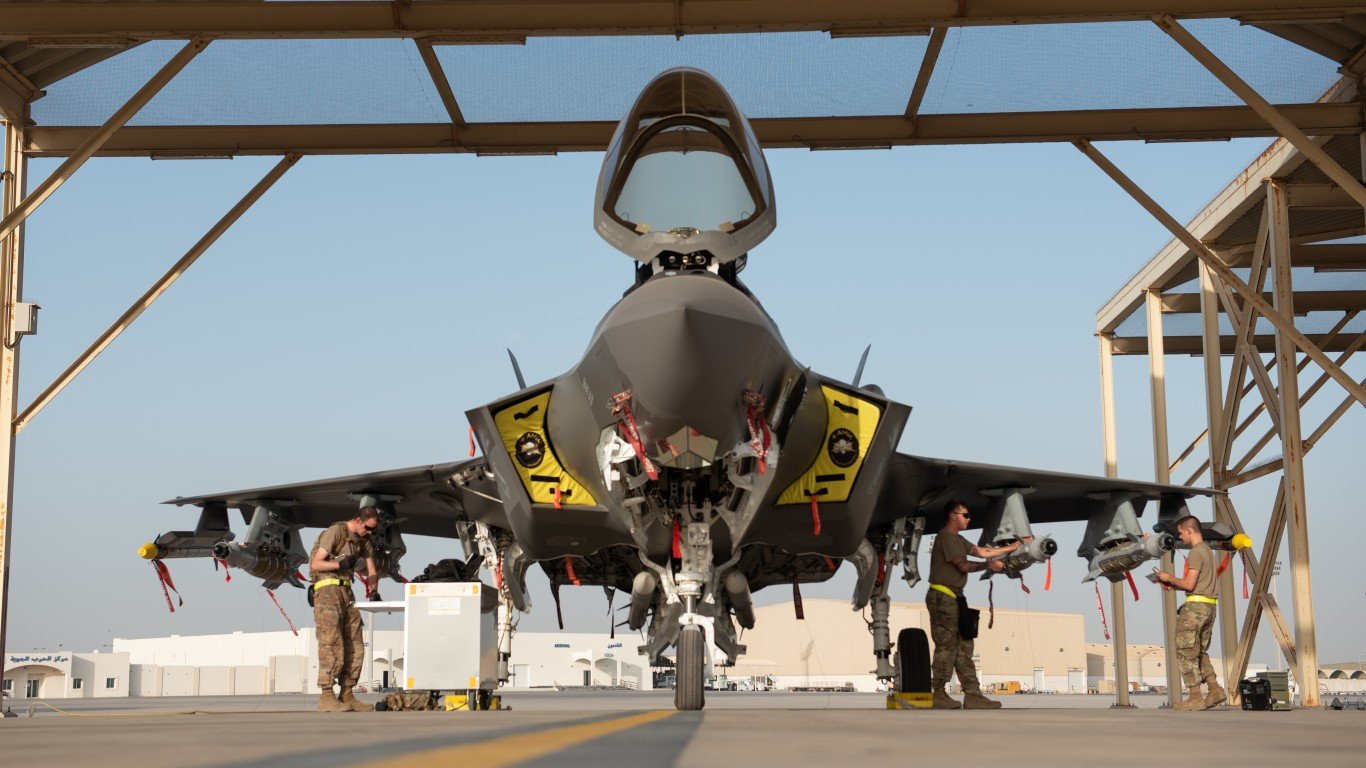

U.S. markets got off to a rocky start Friday morning. Netflix reported results Thursday afternoon that disappointed investors, primarily because of its uncertain guidance. Both railroad operator CSX and chemicals maker PPG Industries beat earnings and revenue estimates, but both traded down in Friday’s premarket.
Earlier Friday morning, financial services firms Ally and Huntington Bancshares, as well as Schlumberger, also beat on both the top and bottom lines but traded lower in Friday’s premarket session.
[in-text-ad]
We already have previewed three companies set to report earnings on Monday (Halliburton, IBM and Steel Dynamics) and four that will report earnings before markets open on Tuesday (American Express, General Electric, Johnson & Johnson and 3M).
Here is a look at four more firms scheduled to report results first thing Tuesday morning. Yes, it will be a busy day.
Lockheed Martin
Lockheed Martin Corp. (NYSE: LMT) led all U.S. federal contractors in federally obligated payments in 2020, accumulating some $76.8 billion. Of that total, $75.2 billion were awarded to the company’s defense businesses. Lockheed received 13.5% of all federal contract dollars in 2020 and 20.5% of defense dollars.
Over the past 12 months, the company’s stock has added nearly 12%. The Federal Trade Commission earlier this month delayed a decision on the company’s proposed $4.4 billion merger with Aerojet Rocketdyne. The deal received backing from a bipartisan group of U.S. lawmakers in September.
Analysts’ enthusiasm for the stock has diminished since the company reported third-quarter results in October. Now just five of 17 brokerages have a Buy or Strong Buy rating on the stock, compared to nine of 19 in October. Twelve brokerages currently rate the stock at Hold. At a recent price of around $373.60 a share, the upside potential based on a median price target of $387 is 3.6%. At the high price target of $450, the upside potential is 20.4%.
Fourth-quarter revenue is forecast at $17.66 billion, would be up 10.2% sequentially and about 3.7% higher year over year. Adjusted earnings per share (EPS) are expected to come in at $7.14, up about 3% sequentially and up nearly 12% year over year. For full fiscal 2021, Lockheed is expected to post EPS of $26.67, up 8.9%, on sales of $67.02 billion, up 2.5%.
Lockheed stock trades at 14.0 times expected 2021 EPS, 14.0 times estimated 2022 earnings of $26.67 and 13.4 times estimated 2023 earnings of $27.91 per share. The stock’s 52-week range is $319.81 to $396.99, and Lockheed pays an annual dividend of $11.20 (yield of 2.97%). Total shareholder return over the past 12 months was 13.6%.
NextEra Energy
In calendar year 2021, electricity generator NextEra Energy Inc. (NYSE: NEE) posted a share price gain of 23.4%. Since the beginning of this year, the share price has dropped by about 12%. The Florida-based utility is the world’s largest producer of electricity using solar and wind energy and, in October, reported a backlog of signed contracts totaling around 18,540 megawatts. While NextEra’s fortunes do not depend entirely on federal policy, there is little doubt that the company would benefit from a not-quite-dead-yet federal commitment of more than $500 billion to clean energy and the environment.
Fourteen of the 20 ratings on NextEra stock are Buy or Strong Buy. Of the rest, five are Hold ratings. At a share price of around $82.50, the upside potential based on a median price target of $90.50 is about 14.5%. At the high price target of $105, the implied gain is 27.3%.
Fourth-quarter revenue is forecast to come in at $5.8 billion, up 32.8% sequentially and 31.8% year over year. Adjusted EPS are forecast to be lower sequentially by 47.2% at $0.40, which would be flat year over year. For the full year, current estimates call for EPS of $2.52, up 9.2%, on sales of $18.48 billion, up 2.7%.
NextEra shares trade at 32.7 times expected 2021 EPS, 30.1 times estimated 2022 earnings of $2.74 and 27.9 times estimated 2023 earnings of $2.96 per share. The stock’s 52-week range is $68.33 to $93.73, and NextEra pays an annual dividend of $1.54 (yield of 1.86%). Total shareholder return over the past 12 months was 0.71%.
[in-text-ad]
Raytheon
Raytheon Technologies Corp. (NYSE: RTX) has seen its share price increase by about 31% over the past 12 months. The company was the second-largest federal contractor in 2020, with $28.2 billion in committed dollars (4.95% of all federal contract spending) and the second-largest defense contractor with $27.4 billion in obligated dollars (7.47% of all defense dollars). The stock posted an all-time high one week ago but has sagged since.
Of 20 analysts covering the stock, 15 rate the shares a Buy or Strong Buy, and the other five have Hold ratings. At a share price of around $88.40, the upside potential based on a median price target of $105 is nearly 20%. At the high price target of $111, the upside potential is 25.6%.
Analysts expect Raytheon to report fourth-quarter revenue of $17.26 billion, up 6.5% sequentially and 5.1% year over year. Adjusted EPS are expected to reach $1.02, down 18.8% sequentially but up by 37.8% year over year. For the full year, EPS are pegged at $4.22, up 20.5%, on revenue of $64.63, up 1.9%.
Raytheon stock trades at 20.9 times expected 2021 EPS, 17.8 times estimated 2022 earnings of $4.97 and 14.9 times estimated 2023 earnings of $5.94 per share. The stock’s 52-week range is $65.02 to $92.48. Raytheon pays an annual dividend of $2.04 (yield of 2.31%). Total shareholder return over the past 12 months was 32.9%.
Verizon
Telecom giant and Dow Jones industrials component Verizon Communications Inc. (NYSE: VZ) has dropped 2.1% over the past 12 months. The stock fell by 11.5% in 2021. Verizon made the list as one of 2022’s Dogs of the Dow.
Verizon and AT&T recently agreed to delay implementation of their 5G C-band (Ultra Wideband as Verizon calls it) rollout following a Federal Aviation Administration warning of interference with some airplane radar systems. About 10 million people of a planned 100 million will experience the delay. Verizon spent more than $45 billion last year to acquire C-band spectrum for its network.
While analysts are definitely cool toward Verizon’s potential to grow its share price, the company’s massive dividend yield makes it hard to recommend selling the stock. Of 29 analysts, seven rate the stock as a Buy or Strong Buy and 21 rate the shares at Hold. At a share price of around $53.50, the implied gain based on a median price target of $59 is 10.3%. At the high price target of $71, the potential upside is 32.7%.
Fourth-quarter revenue is forecast to come in at $33.92 billion, up about 3% sequentially but down 2.2% year over year. Adjusted EPS are forecast at $1.29, down 8.9% sequentially and up 6.6% year over year. For full fiscal 2021 year, analysts expect Verizon to post EPS of $5.38, up 9.8%, on sales of $133.34 billion, up 3.9%.
Verizon stock trades at 9.9 times expected 2021 EPS, 9.9 times estimated 2022 earnings of $5.39 and 9.7 times estimated 2023 earnings of $5.51 per share. The stock’s 52-week range is $49.69 to $59.95. Verizon pays an annual dividend of $2.56 (yield of 4.79%). Total shareholder return over the past 12 months was negative 2.3%.
Take This Retirement Quiz To Get Matched With A Financial Advisor (Sponsored)
Take the quiz below to get matched with a financial advisor today.
Each advisor has been vetted by SmartAsset and is held to a fiduciary standard to act in your best interests.
Here’s how it works:
1. Answer SmartAsset advisor match quiz
2. Review your pre-screened matches at your leisure. Check out the
advisors’ profiles.
3. Speak with advisors at no cost to you. Have an introductory call on the phone or introduction in person and choose whom to work with in the future
Take the retirement quiz right here.
Thank you for reading! Have some feedback for us?
Contact the 24/7 Wall St. editorial team.
 24/7 Wall St.
24/7 Wall St.


